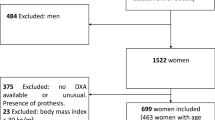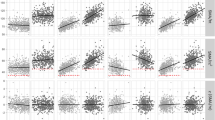Abstract
Although the effect of age on body composition has been intensively discussed during the past 20 years, we do not have a uniform definition of sarcopenia. A suitable definition of low, lean body mass should be based on magnetic resonance imaging (MRI) estimates of muscle mass. Using recent MRI data of a population of 446 healthy free-living Caucasian volunteers (247 females, 199 males) age 18–78 years, a low skeletal muscle mass and sarcopenia were defined as a skeletal muscle mass >1 and >2 s.d. below the mean value obeserved in younger adults at age 18–39 years. The cutoffs for low muscle mass according to the skeletal muscle index (skeletal muscle mass/(height)2) or the appendicular skeletal muscle mass index (skeletal muscle mass of the limbs/(height)2) were 6.75 or 4.36 kg/m2 for females and 8.67 or 5.54 kg/m2 for males, respectively. On the basis of these cutoffs, prevalences of sarcopenia in the group of adults at >60 years are calculated to be 29% in females and 19.0% in males. Faced with different sarcopenic phenotypes (that is, sarcopenia related to frailty and osteopenia; sarcopenic obesity related to metabolic risks; cachexia related to wasting diseases), future definitions of sarcopenia should be extended to the relations between (i) muscle mass and adipose tissue and (ii) muscle mass and bone mass. Suitable cutoffs should be based on the associations between estimates of body compositions and metabolic risks (for axample, insulin resistance), inflammation and muscle function (that is, muscle strength).
This is a preview of subscription content, access via your institution
Access options
Subscribe to this journal
Receive 12 print issues and online access
$259.00 per year
only $21.58 per issue
Buy this article
- Purchase on Springer Link
- Instant access to full article PDF
Prices may be subject to local taxes which are calculated during checkout


Similar content being viewed by others
References
Evans WJ . Skeletal muscle loss: cachexia, sarcopenia, and inactivity. Am J Clin Nutr 2010; 91: 1123 S–1127S.
Haas VK, Kohn MR, Clarke SD, Allen JR, Madden S, Müller MJ et al. Body composition changes in female adolescents with anorexia nervosa. Am J Clin Nutr 2009; 89: 1005–1101.
Frontera WR, Hughes VA, Fielding RA, Fiatarone MA, Evans WJ, Roubenoff R et al. Aging of skeletal muscle: a 12-yr longitudinal study. J Appl Physiol 2000; 88: 1321–1326.
Kortebein P, Ferrando A, Lombeida J, Wolfe R, Evans WJ . Effect of 10 days bedrest on skeletal muscle in healthy older adults. JAMA 2007; 297: 1772–1774.
Plank LD . Protein for the critically ill patient – what and when? Eur J Clin Nutr 2013; 67: 565–568.
Heymsfield SB, Adamek M, Gonzales MC, Jia G, Thomas DM . Assessing skeletal muscle mass: historical overview and state of the art. J Cachexia Sarcopenia Muscle 2014; 5: 9–18.
Cruz-Jentfort J, Baeyenns JP, Bauer JM, Boirie Y, Cederholm T, Landi F et al. Sarcopenia: European consensus on definition and diagnosis: report of the European Working Group on Sarcopenia in Older People. Age and Aging 2010; 39: 412–423.
Müller MJ, Bosy-Westphal A, Kutzner D, Heller M . Metabolically active components of fat free mass and resting energy expenditure in humans: recent lessons from imaging technologies. Obes rev 2002; 3: 113–122.
Janssen I, Heymsfield SB, Ross R . Low relative skeletal muscle mass (sarcopenia) in older persons is associated with functional impairment and physical disability. J Am Ger Soc 2002; 50: 889–896.
Delmonico MJ, Harris TB, Visser M, Park SW, Conroy MB, Vealsquez-Mieyer P et al. Longitudinal study of muscle strength, quality, and adipose tissue infiltration. Am J Clin Nutr 2009; 90: 1579–1585.
Kim TN, Park MS, Yang SJ, Yoo HJ, Kang HJ, Song W et al. Body size phenotypes and low muscle mass: The Korean Sarcopenic Obesity Study (KSOS). J Clin Endocrin Metab 2013; 98: 811–817.
Mourtzakis M, Prado CM, Lieffers JR, Reiman T, McCargar LJ, Baracos VE et al. A practical and precise approach to quantification of body composition in cancer patients using computed tomography images acquired during routine care. Appl Physiol Nutr Metab. 2008; 33: 997–1006.
Prado CM, Liefers JR, McCargar LJ, Reiman T, Sawyer MB, Martin L et al. Prevalence and clinical implications of sarcopenic obesity in patients with solid tumours of the respiratory and gastrointestinal tracts: a population-based study. Lancet Oncol 2008; 9: 629–635.
Baracos VE, Reiman T, Mourtzakis M, Gioulbasanis I, Antoun S . Body composition in patients with non-small cell lung cancer: a contemporary view of cancer cachexia with the use of computed tomography image analysis. Am J Clin Nutr 2010; 91: 1133S–1137S.
Goodpaster BH, Park SW, Harris TB, Kritchevsky SB, Nevitt M, Schwartz AV et al. The loss of skeletal muscle strength, mass, and quality in older adults: the health, aging and body composition study. J Gerontol A Biol Sci Med Sci 2006; 61: 1059–1064.
Norman K, Pirlich M, Sorensen J, Christensen P, Kemps M, Schütz T et al. Bioimpedance vector analysis as a measure of muscle function. Clin Nutr. 2009; 28: 78–82.
Kelly TL, Wilson KE, Heymsfield SB . Dual Energy X-Ray Absorptiometry Body Composition Reference values from NHANES. PLoS One 2009; 4: e7038.
Kim J, Wang Z, Heymsfield SB, Baumgartner RN, Gallagher D . Total-body skeletal muscle mass: estimation by a new dual-energy X-ray absorptiometry method. Am J Clin Nutr 2022; 76: 378–383.
Lee RC, Wang Z, Heymsfield SB . Skeletal Muscle Mass and Aging: Regional and Whole-Body Measurement Methods. Can J of Appl Physiol 2001; 26: 102–122.
Fearon K, Strasser F, Anker SD, Bosaeus I, Bruera E, Fainsinger RL et al. Definition and classification of cancer cachexia: an international consensus. Lancet oncol 2011; 12: 489–495.
Schutz Y, Kyle UUG, Pichard C . Fat-free mass index and fat mass index percentiles in Caucasian aged 18-68 y. Int J Obes 2002; 26: 953–960.
Norman K, Stobäus N, Zocher D, Bosy-Westphal A, Szramek A, Scheufele R et al. Cutoff percentiles of bioelectrical phase angle predict functionality, quality of life, and mortality in patients with cancer. Am J Clin Nutr 2010; 92: 612–619.
Janssen I, Heymsfield SB, Wang Z, Ross R . Skeletal muscle mass and distribution in 468 men and women aged 18-88 yr. J Appl Physiol 2000; 89: 81–88.
Later W, Bosy-Westphal A, Kossel E, Glüer CC, Heller M, Müller MJ et al. Is the 1975 Reference Man still a suitable reference? Eur J Clin Nutr 2010; 64: 1035–1042.
Müller MJ, Langemann D, Gehrke I, Later W, Heller M, Glüer CC et al. Effect of constitution on mass of individual organs and their association with metabolic rate in humans-a detailed view on allometric scaling. PLoS One 2011; 6: e22732.
Heymsfield SB, Thomas D, Bosy-Westphal A, Shen W, Peterson CM, Müller MJ et al. Evolving concepts on adjusting human resting energy expenditure measurements for body size. Obes Rev 2012; 13: 1001–1014.
Heymsfield SB, Müller MJ, Bosy-Westphal A, Thomas D, Shen W . Human brain mass: similar body composition associations as observed across mammals. Am J Hum Biol. 2012; 24: 479–485.
Müller MJ, Wang Z, Heymsfield SB, Schautz B, Bosy-Westphal A . Advances in the understanding of specific metabolic rates of major organs and tissues in humans. Curr Opin Clin Nutr Metab Care 2013; 16: 501–508.
Bosy-Westphal A, Braun W, Schautz B, Müller MJ . Issues in characterizing resting energy expenditure in obesity and after weight loss. Front Physiol 2013; 4: 47.
Mensink GBM, Schienkiewitz A, Haftenberger M, Lampert T, Ziese T, Scheidt-Nave C et al. Übergewicht und Adipositas in Deutschland. Ergebnisse der Studie zur Gesundheit Erwachsener in Deutschland (DEGS1). Bundesgesundheitsblatt 2013; 56: 786–794.
Baumgartner RN . Age. Human Body Composition. 2nd edn. Human Kinetics: Champaign, IL, USA, 2005, pp 59–269.
Schaap LA, Koster A, Visser M . Adiposity, Muscle Mass, and Muscle Strength in Relation to Functional Decline in Older Persons. Epidemiol Rev 2012; 35: 51–65.
Vlassopoulos A, Combet E, Lean ME . Changing distributions of body size and adiposity with age. Int J Obes 2013; 38: 857–864.
Bosy-Westphal A, Booke C-A, Blöcker T, Kossel E, Goele K, Later W et al. Measurement site for waist circumference affects its accuracy as an index of visceral and abdominal subcutaneaous fat in a Caucasian population. J Nutr 2010; 140: 954–961.
Schautz B, Later W, Heller M, Müller MJ, Bosy-Westphal A . Total and regional relationship between lean and fat mass with increasing adiposity—impact for the diagnosis of sarcopenic obesity. Eur J Clin Nutr 2012; 66: 1356–1361.
Schautz B, Later W, Heller M, Peters A, Müller MJ, Bosy-Westphal A et al. Impact of age on leptin and adiponectin independent of adiposity. Br J Nutr 2012; 108: 363–370.
Taaffe DR, Cauley JA, Danielson M, Nevitt MC, Lang TF, Bauer DC et al. Race and sex effects on the association between muscle strength, soft tissue, and bone mineral density in healthy elders: the Health, Aging, and Body Composition Study. J Bone Miner Res 2001; 16: 1343–1352.
Compston JE, Flahive J, Hosmer DW, Watts NB, Siris ES, Silverman S et al. Relationship of weight, height, and body mass index with fracture risk at different sites in postmenopausal women: The global longitudinal study of osteoporosis in women (GLOW). J Bone Miner Res. 2014; 29: 487–493.
Müller MJ, Baracos V, Bosy-Westphal A, Dulloo A, Eckel J, Fearon KCH et al. Functional body composition and related aspects in research on obesity and cachexia. Obes rev 2014; 15: 640–656.
Koster A1, Ding J, Stenholm S, Caserotti P, Houston DK, Nicklas BJ et al. Does the amount of fat mass predict age-related loss of lean mass, muscle strength, and muscle quality in older adults? J Gerontol A Biol Sci Med Sci 2011; 66: 888–895.
Bosy-Westphal A, Eichhorn C, Kutzner D, Illner K, Heller M, Müller MJ et al. The age-related decline in resting energy expenditure in humans is due to the loss of fat-free mass and to alterations in its metabolically active components. J Nutr 2003; 133: 2356–2362.
Müller MJ . From BMI to functional body composition. Eur J Clin Nutr 2013; 67: 1119–1121.
Baumgartner RN . Body composition in healthy aging. Ann NY Academy of Sci 2000; 904: 437–448.
Acknowledgements
The study was funded by a grant from the German Ministry of Education and Research (BMBF 0315681) and BMBF Competent Network of Obesity (CNO). We thank Drs Britta Schautz and Wiebke Braun for their work on segmentations of MRI images.
Author information
Authors and Affiliations
Corresponding author
Ethics declarations
Competing interests
The authors declare no conflict of interest.
Rights and permissions
About this article
Cite this article
Müller, M., Geisler, C., Pourhassan, M. et al. Assessment and definition of lean body mass deficiency in the elderly. Eur J Clin Nutr 68, 1220–1227 (2014). https://doi.org/10.1038/ejcn.2014.169
Received:
Accepted:
Published:
Issue Date:
DOI: https://doi.org/10.1038/ejcn.2014.169
This article is cited by
-
Development of a fully automatic deep learning system for L3 selection and body composition assessment on computed tomography
Scientific Reports (2021)
-
Development of quantification software for evaluating body composition contents and its clinical application in sarcopenic obesity
Scientific Reports (2020)
-
Body composition-related functions: a problem-oriented approach to phenotyping
European Journal of Clinical Nutrition (2019)
-
Comparisons of different indices of low muscle mass in relationship with cardiometabolic disorder
Scientific Reports (2019)
-
The Effect of Age upon the Interrelationship of BMI and Inpatient Health Outcomes
The Journal of nutrition, health and aging (2019)



